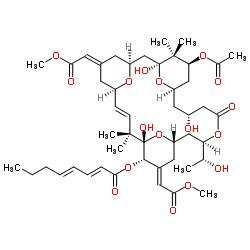83314-01-6
| Name | Bryostatin 1,(1S,3S,5Z,7R,8E,11S,12S,13E,15S,17R,21R,23R,25S)-25-(Acetyloxy)-1,11,21-trihydroxy-17-[(1R)-1-hydroxyethyl]-5,13-bis(2-methoxy-2-oxoethylidene)-10,10,26,26-tetramethyl-19-oxo-18,27,28,29-tetraoxatetracyclo[21.3.1.13,7.111,15]nonacos-8-en-12-y |
|---|---|
| Synonyms |
2,4-Octadienoic acid, (1S,3S,5Z,7R,8E,11S,12S,13E,15S,17R,21R,23R,25S)-25-(acetyloxy)-1,11,21-trihydroxy-17-[(1R)-1-hydroxyethyl]-5,13-bis(2-methoxy-2-oxoethylidene)-10,10,26,26-tetramethyl-19-oxo-18, ;27,28,29-tetraoxatetracyclo[21.3.1.1.1]nonacos-8-en-12-yl ester, (2E,4E)-
(1S,3S,5Z,7R,8E,11S,12S,13E,15S,17R,21R,23R,25S)-25-Acetoxy-1,11,21-trihydroxy-17-[(1R)-1-hydroxyethyl]-5,13-bis(2-methoxy-2-oxoethylidene)-10,10,26,26-tetramethyl-19-oxo-18,27,28,29-tetraoxatetracyclo[21.3.1.1.1]nonacos-8-en-12-yl (2E,4E)-2,4-octadienoate 2,4-octadienoic acid, (1S,3S,5Z,7R,8E,11S,12S,13E,15S,17R,21R,23R,25S)-25-(acetyloxy)-1,11,21-trihydroxy-17-[(1R)-1-hydroxyethyl]-5,13-bis(2-methoxy-2-oxoethylidene)-10,10,26,26-tetramethyl-19-oxo-18,27,28,29-tetraoxatetracyclo[21.3.1.1.1]nonacos-8-en-12-yl ester, (2E,4E)- MFCD00893832 bryostatin1,0 (1S,3S,5Z,7R,8E,11S,12S,13E,15S,17R,21R,23R,25S)-25-Acetoxy-1,11,21-trihydroxy-17-[(1R)-1-hydroxyethyl]-5,13-bis(2-methoxy-2-oxoethylidene)-10,10,26,26-tetramethyl-19-oxo-18,27,28,29-tetraoxatetracycl ;o[21.3.1.1.1]nonacos-8-en-12-yl (2E,4E)-2,4-octadienoate (1S,3S,5Z,7R,8E,11S,12S,13E,15S,17R,21R,23R,25S)-25-(acetyloxy)-1,11,21-trihydroxy-17-[(1R)-1-hydroxyethyl]-5,13-bis(2-methoxy-2-oxoethylidene)-10,10,26,26-tetramethyl-19-oxo-18,27,28,29-tetraoxatetracyclo[21.3.1.1.1]nonacos-8-en-12-yl (2E,4E)-octa-2,4-dienoate BRYO 1 bryostatine-1 BRYOSTATIN 1 BRYOSTATIN |
| Description | Bryostatin 1 is a natural macrolide isolated from the bryozoan Bugula neritina and is a potent and central nervous system (CNS)-permeable PKC modulator. Bryostatin 1 binds to the isolated C1 domain of Munc13-1 and the full-length Munc13-1 protein with Kis of 8.07 nM and 0.45 nM, respectively. Bryostatin 1 has anti-cancer, anti-inflammatory, neuroprotective, anti-HIV-1 infection properties[1][2][3][4]. |
|---|---|
| Related Catalog | |
| Target |
PKC[1] HIV-1[4] |
| In Vitro | Bryostatin 1 (1 µM; 5 minutes; HT22 cells) treatment successfully recruits Munc13-1 from the cytosol to the plasma membrane. Effects of Bryostatin 1 on the other Munc13 family members, ubMunc13-2 and bMunc13-2, resembled those of Munc13-1 for translocation [1]. The increased level of expression of Munc13-1 following a 24 h incubation with Bryostatin 1 in both HT22 and primary mouse hippocampal cells is observed[1]. Bryostatin 1 can also affect the immune system by modulating dendritic cells (DCs) via toll-like receptor 4 (TLR4) through the MyD88-independent pathway, which favors an anti-inflammatory environment by inducing a type 2 phenotype that promotes the differentiation of CD4+ T-helper (Th) lymphocytes into Th2 versus Th1 effector cells[2]. Western Blot Analysis[1] Cell Line: HT22 cells Concentration: 1 µM Incubation Time: 5 minutes Result: Caused Munc13-1 to transfer to the membrane fraction. |
| In Vivo | Bryostatin 1 (30 μg/kg; intraperitoneal injection; 3 d per week; for 2 weeks; C57BL/6J mice) treatment abolishes the onset of EAE[2]. Animal Model: Female C57BL/6J mice (8-12-week-old) with MOG35-55[2] Dosage: 30 μg/kg Administration: Intraperitoneal injection; 3 d per week; for 2 weeks Result: Abolished the onset of experimental autoimmune encephalomyelitis (EAE). |
| References |
| Density | 1.3±0.1 g/cm3 |
|---|---|
| Boiling Point | 954.7±65.0 °C at 760 mmHg |
| Molecular Formula | C47H68O17 |
| Molecular Weight | 905.033 |
| Flash Point | 270.0±27.8 °C |
| Exact Mass | 904.445679 |
| PSA | 240.11000 |
| LogP | 5.39 |
| Vapour Pressure | 0.0±0.6 mmHg at 25°C |
| Index of Refraction | 1.565 |
CHEMICAL IDENTIFICATION
HEALTH HAZARD DATAACUTE TOXICITY DATAMUTATION DATA
|
| Personal Protective Equipment | Eyeshields;Gloves;type N95 (US);type P1 (EN143) respirator filter |
|---|---|
| Safety Phrases | S22-S24/25 |
| RIDADR | NONH for all modes of transport |
| RTECS | EH9455000 |
